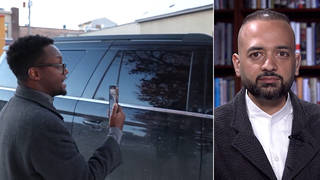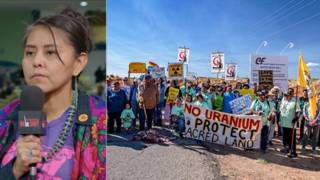
There’s one issue that President Bush and presidential hopefuls John McCain and Barack Obama all agree on: expanding the use of nuclear power. We speak with Amory Lovins, the co-founder, chairman and chief scientist of Rocky Mountain Institute in Colorado, who has been described as “one of the Western world’s most influential energy thinkers.” [includes rush transcript]
Transcript
AMY GOODMAN: There’s one issue President Bush and presidential hopefuls John McCain and Barack Obama all agree on: expanding the use of nuclear power. President Bush addressed nuclear power at a news conference Tuesday and hailed it as a way to reduce American dependence on oil and protect the environment.
PRESIDENT GEORGE W. BUSH: This is just a transition period. I mean, all of us want to get away from reliance upon hydrocarbons, but it’s not going to happen overnight. You know, one of these days, people are going to be using battery technologies in their cars. You’ve heard me say this a lot, and I’m confident it’s going to happen. And, you know, the throwaway line, of course, is that your car won’t have to look like a golf cart. But the question then becomes, where are we going to get electricity? And that’s why I’m a big believer in nuclear power, to be able to make us less dependent on oil and better stewards of the environment. But there is a transition period during the hydrocarbon era, and it hasn’t ended yet, as our people now know. Gasoline prices are high.
AMY GOODMAN: And this is presidential hopefuls Barack Obama, beginning with, though, Senator John McCain, on nuclear power.
SEN. BARACK OBAMA: I actually think that we should explore nuclear power as part of the energy mix. There are no silver bullets to this issue. We’ve got to develop solar. I’ve proposed drastically increasing fuel-efficiency standards on cars, an aggressive cap on the amount of greenhouse gases that can be emitted. But we’re going to have to try a series of different approaches.
SEN. JOHN McCAIN: My dear friends, nuclear power must be part of any equation that leads to addressing climate change and also leads to addressing reduction of our dependence on foreign oil. You know, we always love to imitate the French. The French, 80 percent of their electricity in France is generated by nuclear power. We either got to reprocess it or store it.
AMY GOODMAN: Senator John McCain, and before that, Senator Barack Obama.
Well, the debate over nuclear power is back in the news with the admission of Energy Department official Ward Sproat on Tuesday that it would cost taxpayers $90 billion to open and operate the nation’s first nuclear waste dump. Speaking after a congressional hearing, Sproat added the dump at Yucca Mountain in Nevada would open only in 2020. It was originally estimated to cost $58 billion and open in 1998.
Well, our next guest has been described as “one of the Western world’s most influential energy thinkers.” He’s also a leading opponent of nuclear power. Amory Lovins is co-founder, chair and chief scientist of Rocky Mountain Institute in Colorado. He is a consultant physicist, MacArthur Fellow, and recipient of numerous awards, including the Right Livelihood Award. Lovins advised the energy and other industries in countries around the world, including here in the US. He invented the hybrid Hypercar in ’91 and has written twenty-nine books, including Soft Energy Paths, Natural Capitalism, Small Is Profitable, and Winning the Oil Endgame. Amory Lovins joins us here in our firehouse studio.
Welcome to Democracy Now!
AMORY LOVINS: Thank you.
AMY GOODMAN: It’s good to have you with us. Well, talk about nuclear power. Why do you feel it’s not an option, given the oil crisis?
AMORY LOVINS: Well, first of all, electricity and oil have essentially nothing to do with each other, and anybody who thinks the contrary is really ignorant about energy. Less than two percent of our electricity is made from oil. Less than two percent of our oil makes electricity. Those numbers are falling. And essentially, all the oil involved is actually the heavy, gooey bottom of the barrel you can’t even make mobility fuels out of anyway.
What nuclear would do is displace coal, our most abundant domestic fuel. And this sounds good for climate, but actually, expanding nuclear makes climate change worse, for a very simple reason. Nuclear is incredibly expensive. The costs have just stood up on end lately. Wall Street Journal recently reported that they’re about two to four times the cost that the industry was talking about just a year ago. And the result of that is that if you buy more nuclear plants, you’re going to get about two to ten times less climate solution per dollar, and you’ll get it about twenty to forty times slower, than if you buy instead the cheaper, faster stuff that is walloping nuclear and coal and gas, all kinds of central plans, in the marketplace. And those competitors are efficient use of electricity and what’s called micropower, which is both renewables, except big hydro, and making electricity and heat together, in fact, recent buildings, which takes about half of the money, fuel and carbon of making them separately, as we normally do.
So, nuclear cannot actually deliver the climate or the security benefits claimed for it. It’s unrelated to oil. And it’s grossly uneconomic, which means the nuclear revival that we often hear about is not actually happening. It’s a very carefully fabricated illusion. And the reason it isn’t happening is there are no buyers. That is, Wall Street is not putting a penny of private capital into the industry, despite 100-plus percent subsidies.
AMY GOODMAN: Why?
AMORY LOVINS: It’s uneconomic. It costs, for example, about three times as much as wind power, which is booming.
Let me give you some numbers about what’s happening in the marketplace, because that’s reality, as far as I’m concerned. I really take markets seriously. 2006, the last full year of data we have, nuclear worldwide added a little bit of capacity, more than all of it from upgrading old plants, because the new ones they built were smaller than the retirements of old plants. So they added 1.4 billion watts. Sounds like a lot. Well, it’s about one big plant’s worth worldwide. That was less than photovoltaics, solar cells added in capacity. It was a tenth what wind power added. It was a thirtieth to a fortieth of what micropower added.
AMY GOODMAN: What’s micropower?
AMORY LOVINS: Again, it’s renewables, other than big hydro, plus co-generating electricity and heat together, usually in industry.
In 2006, micropower, for the first time, produced more electricity worldwide than nuclear did. A sixth of the world’s electricity is now micropower, a third of the new electricity. In a dozen industrial countries, micropower makes anywhere from a sixth to over half of all the electricity elsewhere. This is not a fringe activity anymore.
China, which has the world’s most ambitious nuclear program, by the end of 2006 had seven times that much capacity in distributed renewables, and they were growing it seven times faster. Take a look at 2007, in which the US or Spain or China added more wind capacity than the world added nuclear capacity. The US added more wind capacity last year than we’ve added coal capacity in the past five years put together.
And renewables, other than big hydro, got last year $71 billion of private capital; nuclear, as usual, got zero. It is only bought by central planners with a draw on the public purse. What does this tell you? I mean, what part of the story does anybody who take markets seriously not get?
AMY GOODMAN: And yet, well, the media clearly in this country doesn’t get it, because it is raised over and over again by the candidates. I mean, it seems that Senator McCain has a favorite number: a hundred years in Iraq, also hoping for a hundred more new nuclear power plants. He had said something about, he doesn’t want to lose the knowledge of building, since the last one was built more than thirty years ago; the people are dying who had built it, so we’ve got to rush and build them now.
AMORY LOVINS: Well, you could say that’s already been lost, in the sense that most of a nuclear plant built now in the US, if there were any, would have to be imported, which, by the way, means we buy it in weak US dollars, which is part of the incredible cost escalation we’ve seen. Moody’s latest number is $7,500 a kilowatt. That’s, again, as the Journal said, about two to four times the numbers that were being bandied about just last year by promoters.
AMY GOODMAN: And Barack Obama, while he hasn’t laid out a plan for building, he has a big campaign contributor, Exelon, and has supported the expansion of nuclear power. And, of course, we heard what President Bush has to say.
AMORY LOVINS: Actually, I thought what Senator Obama said was “explore”, which is different. And you will find major environmental groups saying something like “explore” or “consider”, but they will also say very carefully it has to be competitive, it has to be cost-effective. And clearly, that doesn’t even pass the giggle test.
A new nuclear plant, according to Moody’s, would send out electricity for about fifteen cents a kilowatt-hour, which is half, again, as much as the average residential rate. And that doesn’t even account for delivering it to your house. And I think if nuclear plants were built, which I don’t think is likely, you would see incredible rates shock and a big political reaction.
AMY GOODMAN: Environmentalists like Stewart Brand and James Lovelock are pushing nuclear power.
AMORY LOVINS: There are actually four individuals involved in the world who are prominent environmentalists who had that view, and you’ve named two of them.
AMY GOODMAN: Who are the other two?
AMORY LOVINS: Patrick Moore was active in founding Greenpeace back in the ’70s, now works for industry; and Peter Schwartz, who used to be on my board, who used to run group planning for Royal Dutch/Shell, is of the same view. But I can’t think of any others. There are no actual environmental groups who favor nuclear power.
AMY GOODMAN: What is your answer to them, and why have they arrived — these are your old colleagues?
AMORY LOVINS: Well, yeah, a couple of them are old friends. Well, I think they haven’t done their homework. And I keep asking for their analysis and not getting it, because I don’t think they have one. But they somehow form the view that because nuclear doesn’t emit carbon, it must be a good thing. Well, that’s not good enough.
You need a source that doesn’t emit carbon — nuclear emits a little bit in the fuel cycle and in building plants, and so on. But you need one that doesn’t emit carbon and is faster and cheaper than other ways to do the same thing. You see, renewables don’t emit carbon. Efficiency doesn’t emit carbon. Cogeneration based on recovered waste heat you were throwing away anyhow doesn’t emit carbon, because you already paid for the carbon in making the useful part of the heat in industry. And these sources are a great deal cheaper and faster than nuclear. So if climate’s a problem, we need to invest judiciously, not indiscriminately, to get the most solution per dollar, the most solution per year. Otherwise, we’re making things worse.
AMY GOODMAN: We’re talking to Amory Lovins. He is co-founder, chair and chief scientist at Rocky Mountain Institute, which is based in Aspen in Colorado?
AMORY LOVINS: Old Snowmass.
AMY GOODMAN: Old Snowmass. Nuclear power is one of the issues that is being posed as an alternative to reliance on foreign fuel, and this is also an issue we addressed yesterday with Naomi Klein on Democracy Now!
, the issue of expanding oil drilling, offshore and onshore. You’ve been looking at this.
AMORY LOVINS: Well, we seem to be wanting to drill in all the wrong places. For example, over fifty times as much oil as might be under the Arctic Refuge at very high prices can be saved at very low prices by using the oil efficiently. Also many times faster. So, my wildcatters have been drilling lately in the Detroit formation. That is, making efficient cars is equivalent to finding an all-American Saudi Arabia under Detroit, about eight-and-a-half million barrels a day, inexhaustible, climate-safe and costing about twelve bucks a barrel. Now, altogether, there is about 14 million barrels a day of oil savings, averaging twelve bucks a barrel cost. And we know exactly where the oil is. There’s no doubt that it’s there. It’s under Detroit, Seattle, and so on. That’s out of twenty-or-so million barrels a day we’re using. So if you’re an oil company and you go to the ends of the earth and drill for very expensive oil that might not even be there, wouldn’t it be embarrassing if somebody else meanwhile found all that cheap oil under Detroit? Shouldn’t we drill the most prospective place first?
I’ve tried this formulation lately on the American Association of Petroleum Geologists and the American Petroleum Institute, and they found it pretty persuasive. You know, I’ve worked for major oil companies for about thirty-five years, and they understand how expensive it is to drill for oil. Take the Arctic Refuge as an example. You might think that at today’s oil prices, it would be clearly a great deal to go drill there. Well, it wasn’t before, when oil was in the twenty-odd dollar a barrel range instead of $140. And that’s why the oil companies weren’t interested. Guess what. They’re still not interested. Why not? Well, because their costs of drilling have gone up more than the oil price went up. If you talk to people who run exploration in major oil companies, they’re still not excited about the Arctic Refuge, because practically any other place in the world they could drill would be cheaper and less risky than that extraordinarily remote and hostile environment.
AMY GOODMAN: So why is Bush pushing it?
AMORY LOVINS: Who knows? But it doesn’t make any economic sense. There’s no business case for it. And the real showstopper, interestingly, is national security, which you would think that he and Senator McCain and so on would be concerned about. Jim Woolsey, a not-hostile-to-oil, per se, Oklahoman, former —-
AMY GOODMAN: Former CIA director.
AMORY LOVINS: —- former CIA director, has actually testified against Arctic Refuge drilling on national security grounds. There’s a very simple reason. There’s only one way to get the oil south: it’s through the Trans-Alaska Pipeline, which is the most vulnerable part of our energy infrastructure, the biggest terrorist target in our energy infrastructure. It’s what he calls Uncle Sam’s “kick me” sign.
So, think about it. You’ve got an 800-mile pipeline, mostly above ground, mostly accessible by road or by floatplane. And if the flow through it is interrupted in the winter for about a week, 900 — well, nine million barrels of hot oil congeals into the world’s largest Chapstick, a big candle. Then you can’t pump it anymore. Could this happen? Well, actually, yes, if certain points on the pipeline, pumping stations and so on, were attacked —-
AMY GOODMAN: We’ve got five seconds.
AMORY LOVINS: —- or stuff at either end. And has that happened? Well, let’s see. It’s been sabotaged, almost blew itself up on occasion through mismanagement. It’s been incompetently bombed twice. It’s been shot at fifty times. A drunk shut it down with one hole from a rifle bullet. And the scariest thing to me is around Y2K, at the turn of the century, a disgruntled engineer was caught by accident about to blow up three critical points with fourteen bombs he had built and tested.
AMY GOODMAN: We’re going to have to leave it there. But one answer: have we solved the nuclear waste problem even?
AMORY LOVINS: No, but I’d just come off the wagon on the economics, and then we don’t need to argue about whether it’s safe.
AMY GOODMAN: Amory Lovins, head of Rocky Mountain Institute, thanks for joining us.












Media Options